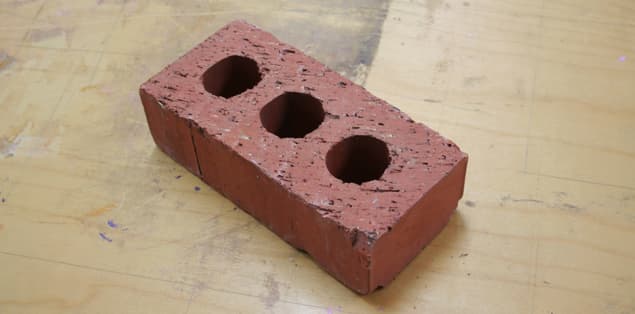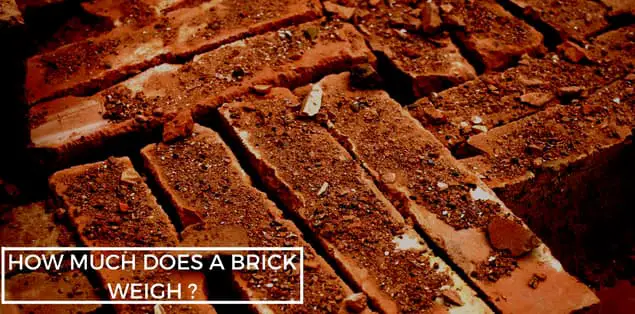So, How Much Does a Brick Weigh? Despite masonry standards, it is unusual to come across a pile of bricks that are the same weight. As a result, you must utilize bricks of average weight.
For millennia, builders have employed bricks in buildings. People formed early bricks of clay, like many modern bricks. People used mud and straw in certain circumstances. However, it was after the Industrial Revolution that builders widely used bricks in buildings. Bricks had become the predominant construction material for commercial establishments at the turn of the twentieth century.
In the same way, as concrete blocks vary in weight based on their physical dimensions, the weight of bricks varies based on density changes among bricks of the same size.
In this article, we’ll find out how much different types of bricks weigh.
So, without any further ado, let’s jump right into it!
How Much Does a Standard Red Brick Weigh?

4.5 pounds.
Asking “What does a brick weigh?” is approximately like asking “What does a human weigh?” It is largely dependent on the kind of brick you’re using. Over one hundred distinct kinds of “bricks” are going to be available.
Bricks come in various forms, including burnt clay bricks, engineering bricks, paver bricks, hollow bricks, solid bricks, and so on. When it comes to the construction of buildings, the act of carrying them or transporting them in a vehicle, weight is an important consideration. You need to be aware of the maximum weight your vehicle can transport before you go brick shopping.
What would you say the typical weight of red brick is?
Oh, the ever-present red brick gets its name from the hue it takes on after being heated in an oven. The high clay component gives the substance a hue similar to rust when heated. During the production process, you may dye these bricks in various colors, but the traditional brick color is red. This is the brick that most people think of when they hear the term “brick.”
About 4.5 pounds is the typical weight associated with a regular red brick. That comes to a total of 2,041 grams or 2.04 kg.
Using that value as the standard, one ton is equivalent to 444.44 bricks. Considering that a regular pallet can store up to 500 bricks of this size, a single pallet’s worth of bricks will weigh a total of 2,250 pounds.
However, these are only the averages. Bricks may have somewhat different weights since manufacturers make them differently, as was previously mentioned. A red brick is considered as a modular brick.
What Is the Size of a Standard Red Brick?
The American Society for Testing and Materials regulates the measurements that determine what constitutes a standard brick in the United States. This indicates that every standard brick produced in the nation adheres to the same measuring standards, implying that they should all weigh around the same amount.
According to the American Society for Testing and Materials, the standard specifications for a red brick are 3⅝ inches by 2¼ inches by 8 inches (92 mm x 57 mm x 203 mm). We sometimes refer to them as a normal eight-inch brick, so keep an ear out for that term.
The measurements indicate that a typical red brick weighs 5 pounds. However, this number may range from as low as 4.3 pounds to 5 pounds, based on the clay used to make the brick. In addition, makers don’t make bricks that conform to industry standards to weigh more than five pounds on average.
Does Brick Weight Matter?

Both yes and no. Bricks with a higher density are often able to support greater loads. You may use them effectively to construct more robust foundations. Nevertheless, the logistics of the bricks are the primary worry at this juncture. Brick transportation is a significant undertaking that may be challenging even if you have a high-end vehicle to assist you in moving the bricks from place to place.
You may accurately characterize the influence of weight by saying that it is more often about the “how” than the “why.” Therefore, it is important to keep in mind that the weight of a brick does not always correspond with the amount of weight it can support. For example, suppose you are unclear about how much weight your bricks can support. In this case, the best thing you can do is to speak with someone aware of this information and can assist you in selecting the appropriate amount.
How Much Does a Concrete Brick Weigh?

A normal cinder or concrete block weighs around 35 pounds (16 kilograms), which people consider to be the average weight of a concrete block. In the United States, the conventional size measures 8 inches x 8 inches by 16 inches. Concrete blocks are a versatile building material that builders may use in many kinds of construction. The proper noun for this product is a CMU (concrete masonry unit).
How Much Does a Brick With Holes Weigh?

Bricks that have holes typically weigh between 3.5 to 3.8 pounds. Certain specific bricks available have several holes in them to make them lighter. This is because the bricks themselves are fairly heavy, which is why there is a need for these specialty bricks.
In addition, there are several advantages to using bricks with holes. First, when you cook the bricks, this helps to ensure that the heat is distributed evenly throughout the oven. As a consequence of this, it will also work perfectly to cure. The holes make it possible to construct any structure more securely and efficiently.
Bricks that weigh less are easier to lift and transport. Therefore, you can transport a greater quantity of bricks on a truck than the usual standard bricks.
You won’t need as much storage space as a result, and it won’t cost you as much. That’s because you can move a greater quantity of bricks at once without placing more strain on your vehicle. In addition, it will reduce the number of trips required to reach the location, which will result in cost savings.
How Much Do 1000 Bricks Weigh?
The weight of the brick might change depending on the size. Therefore, for the sake of this calculation, a brick that weighs 5 pounds has been deemed the standard. Therefore, to calculate the total weight of one thousand bricks, we must first determine the weight of a single brick and then multiply that value by one thousand.
Therefore, the overall weight of one thousand bricks equals five thousand pounds. If there are heavier bricks than this one, they will weigh proportionally more. Considering that each of the one thousand bricks weighs 4.5 pounds brings the total weight to 4500 pounds.
Knowing general calculations is important to calculate brick weight.
How Much Does a Split Brick Weigh?
Each half of a split brick weighs around 4 pounds on average. These bricks may sometimes weigh more than four pounds each, depending on the thickness of the individual piece. For example, construction projects may greatly benefit from using split bricks, also referred to as hard bricks.
These bricks are referred to as super-duty fire bricks due to their exceptional strength and capacity to withstand temperatures above 3000 degrees Fahrenheit in various applications. In addition, they experience a lesser level of shrinkage than other materials.
Bricks that builders have split in half provide a high level of protection against the damaging effects of thermal shock, alkali, and carbon monoxide. You may also get the split bricks with a thickness of 2.5 inches, and each of these bricks weighs roughly 8 pounds.
The price of these bricks is a little bit more than average. However, using them to build anything securely is one of the best options. It has a longer lifetime, which means that the structure will ultimately have a longer lifespan due to it.
How Much Does a Brick of Gold Weigh?

Before we can answer how much a brick of gold weighs, we will first need to understand the measurement of a brick of gold. This section will also discuss the “standard” gold bar, the most typical weight for gold bricks, and how you may determine whether or not the gold is worth how much you weigh.
How is the weight of gold determined?
One of the most common units used to measure gold is a troy ounce, which weighs about 1/10 of an ounce more than a regular ounce. In terms of weight, one troy ounce is equal to 31.1034768 grams.
You could see the word “avoirdupois ounce” while trying to distinguish between troy ounces and the standard ounce.
The “Good Delivery” gold bar is the one you can most often see in media such as television programs and movies.
It tips the scales at a massive 27.4 pounds (400 ounces). A single bar is equivalent to around $750,000 in American currency at today’s market rates.
It is permissible for the amount of gold in a Good Delivery bar to range anywhere from 350 to 430 troy ounces. The bar must include a minimum purity of 99.5 percent gold. To preserve their high quality, they must be kept in gold bullion vaults that are well known and very guarded.
Makers sometimes make Good Delivery bars available to the general public since most of them are stored and exchanged globally by central banks and bullion dealers.
How Much Does a Brick of Drugs Weigh?
A brick of drugs weighs about a kilo, i.e., 1000 kilograms.
How Much Does a Pallet of Bricks Weigh?

486 pounds approx.
Bricks on a pallet may have various weights due to factors such as the dimensions of the pallet, the kind of bricks used, and the number of bricks utilized. For example, a pallet with a single line of Lego bricks weighs substantially less than a pallet with a four-foot-high stack of red clay bricks. However, the weight of the latter is significantly more.
If the face of a brick is 7.62 inches by 2.25 inches, then the brick’s surface area is roughly 17 square inches. The dimensions of a typical pallet are 40 inches by 48 inches, which gives it a total area of 1,920 sq. in. According to these measures, there should be around 113 bricks used to fill the pallet. Knowing how many bricks are there in a pallet is essential in finding the weight of the pallet.
If every brick measures 4.3 pounds, then a pallet full of bricks will weigh 486 pounds even if there is only one stack of bricks on it. But on the other hand, the pallet’s mass is not considered in this example.
To find the volume of a brick, multiply the length width, and height of the brick.
How Much Does a Fire Brick Weigh?
3.4 kg to 3.8 kg.
The unit weight of the fire bricks might also vary, depending on the material makers make them of. The size and the mass will vary from one model to the next, depending on which one you choose. The creation weight also varies depending on the bulk density of the substance.
For instance, the relative density of hefty fire bricks is often more than or equal to 2000 kg/m3, while the bulk density of light fire bricks is less than or equal to 1500 kg/m3.
Therefore, you must first establish the mass norm of fire bricks, whether it is a bulky or lightweight fire bricks. It would be best if you made this decision before moving on to the next step. For example, you can estimate the weight by referring to the density index if you adhere to the high-alumina fire GB/T2988-2012 physical and chemical index constant weight norm.
Clay fire bricks typically have a unit weight that ranges from 3.4 kg to 3.8 kg.
How Much Does a Brick Mailbox Weigh?
Depending on its dimensions and configuration, a brick mailbox weighs anywhere from 800 to 1,500 pounds on average. On the other hand, a faux-brick mailbox may weigh between 50 and 75 lbs. without factoring in the weight of the metal pole or the surrounding foundation.
Final Words – How Much Does a Brick Weigh?
Even though there is a wide variety of bricks to choose from, most residents will be interested in standard red clay brick. For example, the weight of a typical red brick is around 5 pounds, a beautiful quantity that is simple to remember and straightforward to work with when doing computations. There are many brick sizes, hence the weight of each brick differs. The red clay brick are considered as modular bricks.
Because bricks will likely continue to play a significant role in the building and design industries, it is important to keep the weight of individual bricks in mind.
